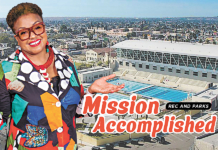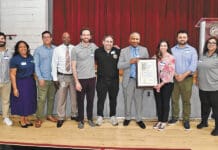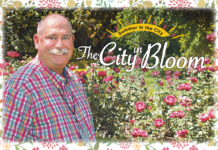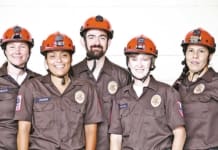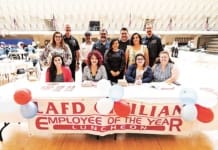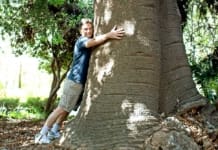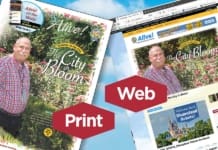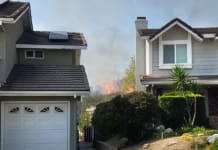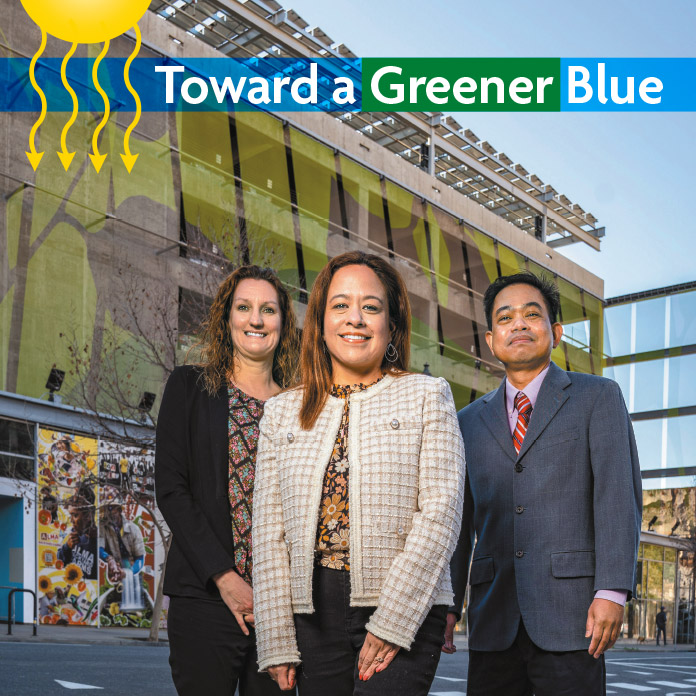
Photos by Summy Lam, Club COO, and courtesy Public Works/Engineering and LAPD
A
new era of sustainable power generation in the City of LA has begun with the completion of the LAPD Motor Transport Division’s Solar Photovoltaic (PV) Array project. The large array, built atop the MTD headquarters building and garage on Main Street downtown, is now generating power for the building, with the remainder deposited back to the LADWP’s power grid. It’s been generating power since Aug. 22, 2022.
The array, the first of its kind in the City, is expected to be a model for power generation for the LAPD and the City as part of LA’s Green New Deal initiative.
A team of engineers and managers from the LAPD, Public Works/Engineering, General Services, the Mayor’s Office and outside consultants and construction companies came together to make it happen. Many other departments played major roles, including Building and Safety, the LAFD, the LADWP and others.
THE NUMBERS
The total installed capacity of the solar PV system is about 580kW DC, with estimated annual electricity production of 953,248 kWh that could support the electricity use of about 131 homes in the United States for one year and offsets approximately 676 metric tons of carbon dioxide (CO2) emissions annually from fossil fuel power plants, according to the Bureau of Engineering. This annual production by PV is also equivalent to avoiding greenhouse gas (GHG) emissions from 146 gas-fueled passenger vehicles driven for one year.
The project also included the installation of electrical, lighting, carport, fire protection, and hose bibbs infrastructures supporting the new solar PV system.
The MTD project is a very significant solar installation and is expected to be a precursor to other PV installations in the City.
The Bureau of Engineering provided project and construction management, including the planning of the solar PV system and reviewing the construction documents to assure that it met the City’s municipal facility requirements and LA’s Green New Deal goals.
The total project construction cost was about $3.3 million and was funded by MIC-LA (Municipal Improvement Corporation of Los Angeles). The design-build contractor was Baker Electric, Inc. The consultant was Gruen Associates and Consultants.
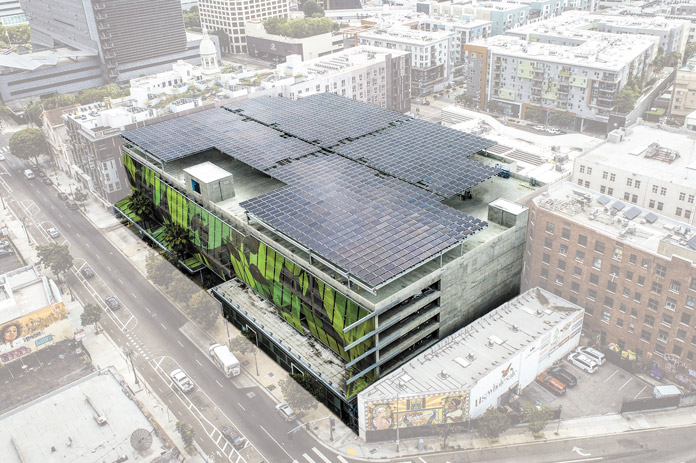
AWARD WINNING
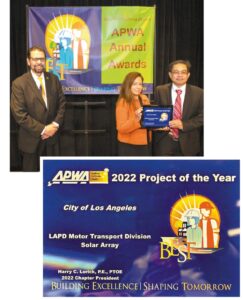
The solar array project was one of two Bureau of Engineering projects that were honored with 2022 Project of the Year Awards presented by the American Public Works Association (APWA) Southern California Chapter. The APWA SoCal BEST (Building Excellence, Shaping Tomorrow) awards recognize the most outstanding projects of the year.
- The LAPD Motor Transport Division (MTD) Solar Array was awarded Project of the Year in the Facilities category.
- The Sixth Street Viaduct Replacement Project, also covered extensively by Alive!, was named Project of the Year in the Transportation category.
Congratulations to both project teams!


![]()
![]()
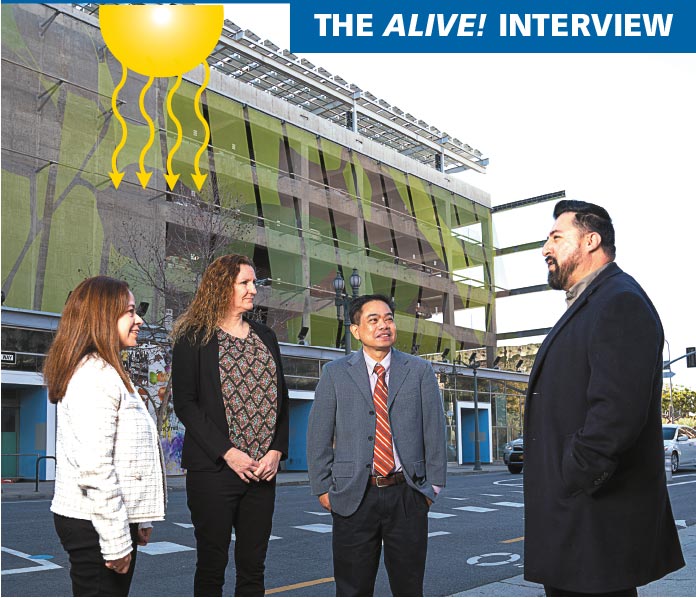
Adding Solar to A Busy Facility
On Feb. 8, Club CEO Robert Larios and Alive! editor John Burnes interviewed members of the team that developed the LAPD’s first solar array: Fidel Oñate, Building Electrical Engineer and Project Manager for Solar and Other Special Projects, Public Works’ Bureau of Engineering, 6 years of City service; Ingrid Reyes, Architectural Associate and Construction Manager for the Solar Array Project, Bureau of Engineering, 15 years, Club Member; and Leslie Herrig, Sr. Management Analyst II and second LAPD Liaison for the solar array project, LAPD, 27 years. Project team members who were unable to participate in the interview were Michael Samulon, Electric Vehicles and City Projects, Mayor’s Office; Grace Hsieh, Office of Sustainability, General Services; and Neel Mistry, Civil Engineer, Bureau of Engineering. • The interview took place via online conference.
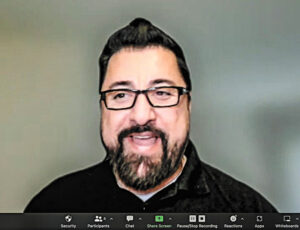
Robert Larios: Thanks for joining us today to talk about this important and impressive project. First, tell us your career path, and how you got to your current position.
Fidel Oñate: I have a Bachelor’s degree in electrical engineering, and my first job was as a building electrician in construction in the field. And then I worked in electrical design for a year back in the Philippines, mainly working for residential and warehouse projects. And then I worked as an electrical design engineer in Saudi Arabia for three years building military housing.
Then I spent five years in Malaysia working for a couple of cement plants in Malaysia and three gas-fueled power plants in the Asia Pacific Region – the Philippines, Vietnam and Australia – as a project engineer or coordinator.
Before I joined the City in 2017, I spent eight years as a senior electrical engineer in a private consulting firm working for school districts and for office building tenant improvement projects. And then another nine-and-a-half years in a private firm as principal engineer for USPS, building Post Office facilities and military training facilities nationwide.
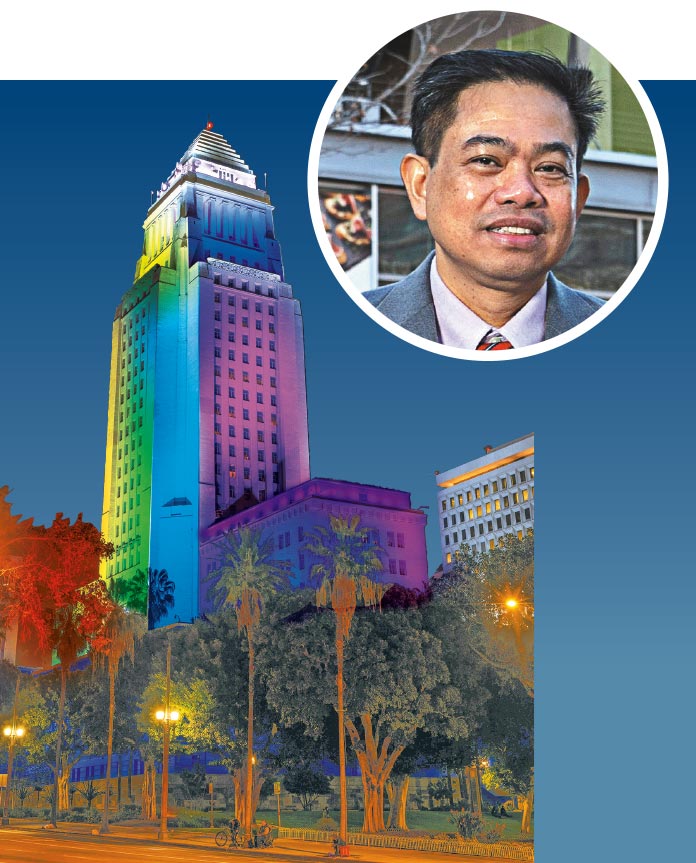
And then I spent three-and-a-half years as an electrical engineer/consultant to the City in the Bureau of Engineering, Environmental Engineering Division working on wastewater treatment plant’s capital improvement projects. From there, I accepted this position as a Building Electrical Engineer / Project Manager in the Bureau of Engineering, Architectural Division for solar PV projects in the City, or any special project – like lighting project, and providing electrical engineering technical support to other City departments for the citywide electric vehicle (EV) charging station projects. Alive! covered the City Hall lighting project. I worked on the electrical design of that project before General Services’ Construction Forces built it.
Yes we did. We love the City Hall lighting program! Great, thanks. Ingrid?
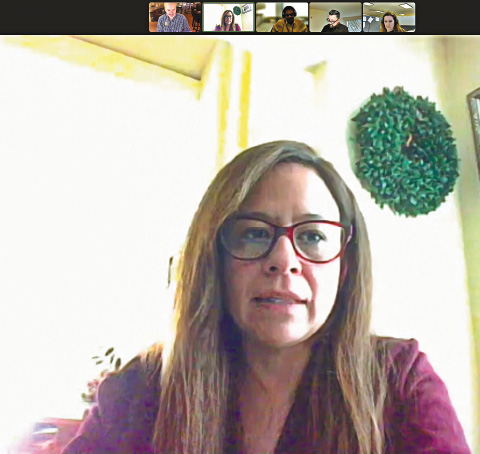
Ingrid Reyes: I started with the City a long time ago. as an intern during my school years of architecture school. I volunteered during that time because the student internship program became available. It was an unpaid intern position, but I was glad to do it as I was eager to learn my field and also to learn what the City of Los Angeles did. After my City internship and as I graduated from architecture school, I was hired by JAG Architects, at that time a historical preservation firm. They were located inside the historical Bradbury Building. Then I went off to work for AC Martin and Partners, a very large architecture firm. Then the position for architectural associate became open within the City, and I applied and got it. I started as an Architectural Associate in design. But then an opportunity to work for the LA Zoo occurred and I started my training to become an Assistant Project Manager and Construction Manager. While working for the Zoo bond, I was an Assistant Project Manager/Assistant Construction Manager for the Reptile Exhibit and oversaw the design development of the Rainforest of the Americas. When that bond project came to an end, I was given the opportunity to work for the police bond, where I also worked as a Project Manager and Construction Manager at the same time. I managed the Northeast Police Station project on San Fernando Road and Treadwell. I also managed the Rampart Police Station project on Temple Street. But then that bond also closed, too. I transferred to the Bureau of Engineering’s Construction Management Division in which I have been primarily a construction manager for various types of projects such as award-winning parks, bathhouse and pool replacements, street projects, lighting, and solar. I very much enjoy construction. I love to be out there and see everything there is about construction.
I also enjoy the other aspects of not being hands-on in the field, but reviewing contractor’s schedules and dealing with contractors and subcontractors – there is always something new to learn. It’s a very interesting position for me.
And when you were working on Zoo and Police bond projects, that was still within the Bureau of Engineering?
Ingrid: Yes, that’s correct.
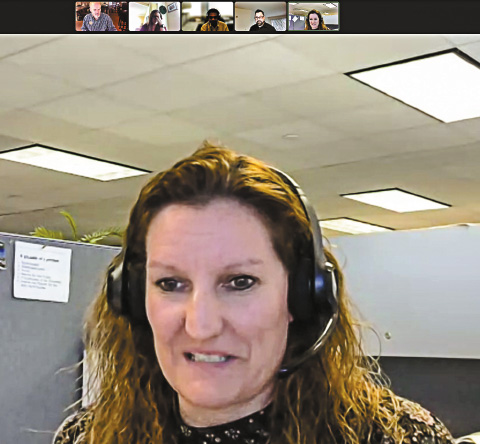
Leslie Herrig: My story is going to be slightly different. I started my career with the City in the Police Academy. I was injured in the Academy and transferred to the civilian side, and I’ve been here my whole career. I was promoted into this position in Facilities Management in May 2021, and to Sr. Management Analyst II the next month.
Is this your first solar project?
Leslie: Yes. [Project team member] Grace Hsieh was here for a number of years, and she started a lot of infrastructure projects as well as this solar project for the LAPD. When she transferred out of LAPD, I inherited this. A lot of the hard work was done prior to my arrival by Grace. As the COVID issues were resolved, I worked with Fidel and Ingrid as they put the solar panels up.
 LAPD’s First Solar Project
LAPD’s First Solar Project
In general terms, describe the solar project that’s above the LAPD parking structure downtown.
Fidel: It’s a solar photovoltaic (PV) system. It’s installed in about 60,000 square feet of the rooftop carport at the LAPD Motor Transport Division parking facility at South Main Street in the Civic Center. It is under Council District 14 and it was completed in August 2022. It is connected to LADWP’s utility grid through net energy metering (NEM) configuration.
This project also included installation of electrical, lighting, carport, and fire protection infrastructures, and also water hose bibbs for cleaning purposes, supporting the solar PV system.
The carport covers many parking spaces on the roof, so it helps people and keeps cars cool. It also provides partial renewable energy to more than 100 electric vehicle (EV) charging stations in the building, plus other electrical loads in the building.
And the excess power goes back to the grid and generates energy credits for the LAPD in terms of electric bills. The system also incorporates the connection for the future battery energy storage system for storing power from the solar PV system.
Ingrid: This project was not typical. Most projects the City does are Design-Bid-Build. This was a one-of-a-kind project on its own for the LAPD as it was a design-build, which means that the City designed the first 30 percent, setting up a standard of performance that we wanted to achieve when we went to bid. Then the contractor studied our 30 percent bridging documents, and then they took it through the 100 percent design process; the contractor now becomes the designer of record and General Contractor. They finished the design with their expertise. This was interesting in that aspect. It was a trial project for the LAPD for building future solar array systems. A lot of it will depend on the percentages of change orders – how much the contractor had to adjust the design from our original 30 percent. But closing out this project with like a 1.5 percent total of change orders, it’s unheard of. Most projects include a contingency of eight to 10 percent change orders. This project only had 1.5 percent. That’s remarkable.
Leslie, how would you describe this project?
Leslie: Finished!
They started working on it years before I got here, and then COVID happened and everything got delayed. When I came in, they were putting up the actual solar panels. I don’t know if that’s the easy part, but Ingrid, Fidel and Grace all worked through the headaches to get to that point. I got to see and work through the completion of it.
I don’t think the City has allotted any more funding at the moment for a second project. We have a list of potential locations to put solar, but we’re waiting on funding to move forward with the next solar project. We’ve made our suggestions.
Right. And just to clarify, the excess power that is produced from this array, the power that goes into the LADWP’s power grid, is for general use? It’s not reserved for just Police Dept. use?
Ingrid: No. It offsets the grid.
Leslie: There’s no battery backup in this. It’s a learning experience – in future projects we’ll look at the resiliency piece so that if the power does go out, then the batteries would be charged and could keep power on in the facility.
Fidel: During the day, let’s say it generates 100 kilowatts from solar PV and the load on the building is 90 kilowatts; it provides that power to the building and returns 10 kilowatts to the grid. We are not storing those 10 kilowatts at this time.
Does that building use a lot of power?
Leslie: It’s more than just a parking structure.
Really, I didn’t know that.
Ingrid: It’s a live structure. It’s used every day 24/7, 365 by LAPD staff. We couldn’t in any way hinder the LAPD Officers who work there.
Leslie: It’s the LAPD Motor Transport Division Admin Office (headquarters) as well as a parking structure for the fleet vehicles assigned to LAPD ‘s Police Administration Building and a fleet service garage.
Ingrid: You also have offices within that parking structure.
Leslie: The LAPD’s Motor Transport Division has its main admin office in that facility. From there they coordinate all the garages at all our facilities and manage LAPD’s entire motorized fleet.
Ingrid: You can imagine what it took to not shut the facility down at any given point.
Leslie: And we put a large solar array on top of that facility.
That’s impressive.
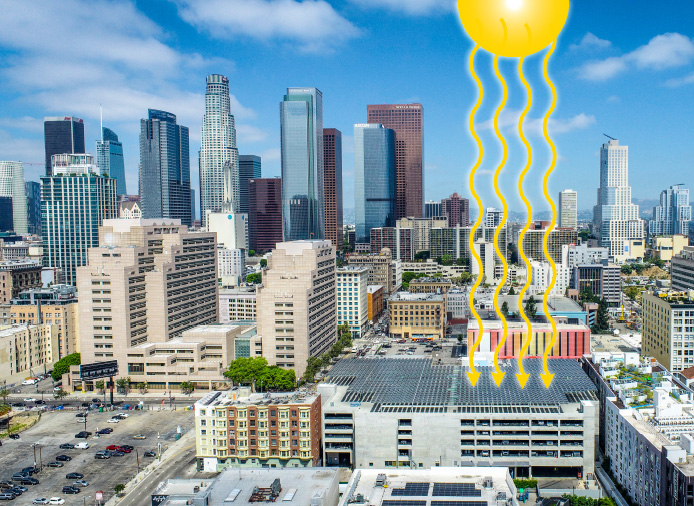
 Project History
Project History
How did this project begin?
Fidel: When I joined the City in July 2017, it was one of the projects initiated through the Mayor’s Office, specifically Michael Samulon. It was on my agenda when I started. Mayor Garcetti had created the Green New Deal for sustainability of LA. It was not specifically stated in the Green New Deal, but generally it’s in line with it. The Green New Deal promotes the renewal of energy in the City.
This solar array is not generating the power from a fossil fuel power plant, but getting it from a renewable source.
Sure, of course. Ingrid, have you been on this project since the very beginning?
Ingrid: My beginning with it was as a construction manager. I was not part of the initial 30 percent design process that the City provided through Fidel and outside consultants. The project was out to bid. And then the project got awarded to the contractor. That’s when I became the lead person for the project construction. I set up pretty much everything, all the parameters that needed to happen, all the design charrettes that were needed to continue. I oversaw everything in the construction from nothing on the ground to the turnover back to the City of the completed project.
As of now, I’m still closing out the project and arranging for the City to take over once the contractor leaves. There’s a list of minimum requirements that need to be met before General Services takes over completely. Almost everything is done, but General Services has the final signature on that.
Got it.
 Importance
Importance
Why is this project important to the City of LA?
Fidel: This creates renewable energy, and it offsets carbon dioxide (CO2) emission. We estimate that it offsets about 676 metric tons of carbon dioxide emissions annually from fossil fuel power plants. It’s really very important because we are helping to reduce gas emissions. And of course, it’s in line with our Green New Deal – it will help Los Angeles to achieve what they call Carbon Neutrality by 2050 and lead by example.
Ingrid: In recent years, the City is moving very heavily on net zero buildings and in general sustainability. All, or at least most, of our buildings need to be sustainable. How much impact is our society having on climate change? What does it mean to have solar in place? There’s only one way to find out.
Leslie: For the Police Dept., it’s important to reach the Mayor’s sustainability goals, and also to move forward with getting the infrastructure in place to support a fleet of electric vehicles in the future.
Is this project more than just for now? Is it a model to see what works and what doesn’t, to gain knowledge for the future? This won’t be the City’s last renewable energy project.
Leslie: Yes.
Ingrid: I concur.
Fidel: Yes. There will be benefits back to the City, like reducing the electric bills. We will be calculating the costs and the benefits of reducing the building’s electric bills because we are creating renewable energy.
 Invisible Infrastructure
Invisible Infrastructure
It’s not always easy to see a solar array when it’s on top of a building. It would be nice for the public to notice the good work that you’re doing on an important project. Does anybody notice it?
Leslie: I’d like to think they do!
Ingrid: They were noticing it when we were in construction – I can’t tell you how difficult it was to get all those I-beams up there! You wouldn’t believe what I had to go through!
Leslie: I believe you.
Ingrid: Because you were there!
Leslie: I was there.
Ingrid: A lot of the folks I work with at the Bureau of Engineering who take the commuter buses have seen it up there, and they tell me, “Wow, Ingrid, that’s impressive. I want to go up there and see it.” It’s an LAPD facility. People can’t just go up there.
I’m assuming the public has seen it, but maybe they don’t really understand its importance. They might not know all the real benefits that it’s having. We put up a small sign during construction that read, “Future LAPD solar array.” Maybe they know.
Fidel: Our BOE website is also accessible to the public and it was published in our newsletter and Facebook page. And it was on the Mayor’s Facebook and Twitter accounts, with very positive feedback.
Ingrid, Leslie and I attended the award ceremony for this project.
Yes, congratulations!
Fidel: We received an American Public Works Association Award, Southern California chapter. People from other cities recognize and know this project.
 Proud of the Power
Proud of the Power
Are you proud of this project?
Leslie: It was nice to see the first LAPD solar project go in, but I feel like I shouldn’t be getting credit for it because I came in at the end.
Ingrid: That is not true. You should be getting credit. You helped a lot.
Leslie: Grace had done a lot, too. It was neat to be part of the first LAPD solar project. It was special.
Fidel: I am really very proud of this project because this was my first solar PV project where I did project management. In the past, I did solar PV projects for U.S. government facilities. But I had never seen the actual construction and installation. I’m looking forward to helping in the future – our bureau is working toward more solar PV projects.
Ingrid: I take pride in every project that I do. There’s always something very rewarding and something that I learn. But this project in particular, we had to work through a very difficult time – COVID. People don’t understand the difficulties we went through – our entire team had to go to get plans checked when Building and Safety offices were closed. And other outside jurisdictions, too. We had to go through fire approvals, and approvals for electrical, building, and all kinds of different clearances – they took forever because of the pandemic. But everybody was really on top of their game, and it was a true delight to have worked with a team that really worked really hard. Yes, we got sick but we bounced right back.
And as I said before, at the end of the day, we’re closing out a project with only 1.5 percent total of change orders, with most projects having a contingency of about eight to 10 percent in change orders. That, in such a difficult time as COVID, and to get an award on top of that, and to have an amicable close, it’s just incredible.
I always take pride in being a partner with all of my contractors. It’s quite an honor for me.
Fidel: We also expect to receive solar incentives from LADWP for this project. They worked to get us an extension for those credits because of the pandemic. I really appreciate the support from LADWP for granting us this extension.
Ingrid: I mean, it was a lot of money. It was half a million dollars.
Fidel: Yes, and we will be using this for the next solar PV projects.
 Passion
Passion
What do you love about what you do?
Ingrid: I love that I get to work with a lot of different types of people and a lot of different types of personalities and entities. The pleasure of being a construction manager is that I get to problem-solve; each project is a beast on its own. I’m a thinker. I love to resolve problems. That’s why I went to architecture school to begin with, but my career path led me to construction management. That’s where my love is.
Fidel: I worked with the Mayor’s Office, the Board of Public Works, and at some point with the CAO office, with Ingrid’s crew, consultants, and others. Working with so many is a challenge, but I love that. That’s why I love this project because you have a lot of challenges, and can resolve it.
And I like learning something that I can share with my colleagues on our team. Sharing it is really amazing.
Leslie: When it comes to the sustainability part of facilities management where I work, getting to witness and be part of the first solar project was an honor, and having Ingrid and Fidel made it quite easy to make it happen. I hope that any future LAPD solar projects involve Ingrid and Fidel, and Baker Electric, too, because it truly was a great experience. They set the bar high.
Well, Fidel, Ingrid and Leslie, thank you for your time today to explain this project to our readers. We know you’re busy.
Leslie: Thank you.
Fidel: Thank you.
Ingrid: Thank you very much for inviting us! n
|
BEHIND THE SCENES
Club VP of Marketing Summy Lam photographs Leslie Herrig, LAPD; Ingrid Reyes, Public Works; and Fidel Oñate, Public Works; under the LAPD’s first large solar array. |




